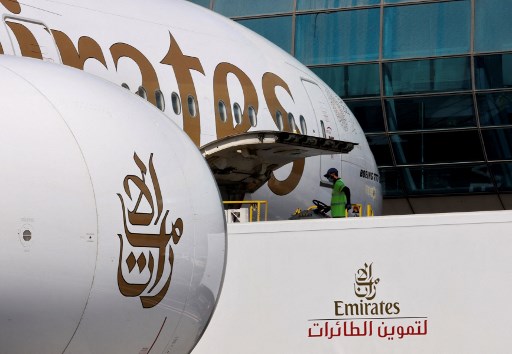
403
Sorry!!
Error! We're sorry, but the page you were looking for doesn't exist.
Aviation Hubs in UAE, Saudi Arabia Predicted to Drive Middle East's Passenger Traffic Recovery
(MENAFN) Industry leaders at the Global Airport Leaders Forum predict that key aviation hubs in the UAE and Saudi Arabia will drive a full recovery of passenger traffic in the Middle East by 2024. The region is forecasted to grow by 4.2 percent annually through to 2040, primarily fueled by aviation hubs like Dubai, Abu Dhabi, and key cities in Saudi Arabia. The probability of the Middle East spearheading the global aviation market in terms of passenger traffic recovery was discussed, highlighting the region's leading traffic numbers in terms of global recovery with 93 percent of pre-COVID-19 levels.
During the forum, Kashif Khalid, Regional Director of the International Air Transport Association, stated that the Middle East is currently leading the traffic numbers in terms of global recovery. On May 9, Dubai Airports revised its 2023 forecast upward to 83.6 million passengers, reflecting the region's growth potential. Dubai's main airport, DXB, registered a 55.8 percent increase in passenger traffic in the first quarter of this year compared to the same period of last year, reaching 95.6 percent of 2019 levels. The operator welcomed around 21.3 million passengers in the first three months of 2023.
The UAE welcomed around 31.8 million passengers across all airports in the first quarter of this year, an increase of 11.48 million passengers compared to the same period last year. The growth is attributed to the region's aviation hubs, which are expected to drive the Middle East's passenger traffic recovery. Key aviation hubs in the UAE and Saudi Arabia are predicted to drive the region's growth, with Dubai, Abu Dhabi, and key cities in Saudi Arabia playing a significant role.
The Middle East's aviation industry is expected to grow by 4.2 percent annually through to 2040, driven by key aviation hubs in the UAE and Saudi Arabia. The region's leading traffic numbers in terms of global recovery with 93 percent of pre-COVID-19 levels indicate its growth potential. Dubai Airports revised its 2023 forecast upward to 83.6 million passengers, reflecting the region's growth potential. The UAE welcomed around 31.8 million passengers in the first quarter of this year, an increase of 11.48 million passengers compared to the same period last year, driven by the region's aviation hubs. The industry leaders predict that key aviation hubs in the UAE and Saudi Arabia will drive the Middle East's passenger traffic recovery and spearhead the global aviation market in terms of passenger traffic recovery.
During the forum, Kashif Khalid, Regional Director of the International Air Transport Association, stated that the Middle East is currently leading the traffic numbers in terms of global recovery. On May 9, Dubai Airports revised its 2023 forecast upward to 83.6 million passengers, reflecting the region's growth potential. Dubai's main airport, DXB, registered a 55.8 percent increase in passenger traffic in the first quarter of this year compared to the same period of last year, reaching 95.6 percent of 2019 levels. The operator welcomed around 21.3 million passengers in the first three months of 2023.
The UAE welcomed around 31.8 million passengers across all airports in the first quarter of this year, an increase of 11.48 million passengers compared to the same period last year. The growth is attributed to the region's aviation hubs, which are expected to drive the Middle East's passenger traffic recovery. Key aviation hubs in the UAE and Saudi Arabia are predicted to drive the region's growth, with Dubai, Abu Dhabi, and key cities in Saudi Arabia playing a significant role.
The Middle East's aviation industry is expected to grow by 4.2 percent annually through to 2040, driven by key aviation hubs in the UAE and Saudi Arabia. The region's leading traffic numbers in terms of global recovery with 93 percent of pre-COVID-19 levels indicate its growth potential. Dubai Airports revised its 2023 forecast upward to 83.6 million passengers, reflecting the region's growth potential. The UAE welcomed around 31.8 million passengers in the first quarter of this year, an increase of 11.48 million passengers compared to the same period last year, driven by the region's aviation hubs. The industry leaders predict that key aviation hubs in the UAE and Saudi Arabia will drive the Middle East's passenger traffic recovery and spearhead the global aviation market in terms of passenger traffic recovery.

Legal Disclaimer:
MENAFN provides the
information “as is” without warranty of any kind. We do not accept
any responsibility or liability for the accuracy, content, images,
videos, licenses, completeness, legality, or reliability of the information
contained in this article. If you have any complaints or copyright
issues related to this article, kindly contact the provider above.
Most popular stories
Market Research

- Bitmex Reports Over 185% Liquidity Growth Following AWS Tokyo Migration
- Tokenfi And New To The Street Announce National Media Partnership To Reach 219M+ Households
- Chartis Research And Metrika Release Comprehensive Framework For Managing Digital Asset Risk
- Xdata Group Named Among The Top 66 Saas Innovators In Techround's 2025 List
- Cregis At TOKEN2049 Singapore 2025: Unlocking The Next Frontier Of Adoption
- On-Chain Cultural Assets: Decoding City Protocol's IP Capital Market



















Comments
No comment